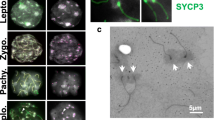Abstract
The chromosomes of Parascaris univalens possess a continuous centromeric structure spanning their entire length in gonial cells. A cytological and ultrastructural analysis of P. univalens meiotic chromosomes was performed. The results show that during meiosis the holocentric germline chromosomes of male P. univalens undergo restriction of kinetic activity to the heterochromatic terminal regions. These regions lack kinetochore structures and interact directly with spindle microtubules.
Similar content being viewed by others
References
Albertson DG, Thomson JN (1982) The kinetochores of Caenorhabditis elegans. Chromosoma 86:409–428
Boveri T (1910) Die Potenzen der Ascaris-Blastomeren bei abgeänderter Furchung. Festschr R Hertwig 3:131–214
Buck RC (1967) Mitosis and meiosis in Rhodnius prolixus: the fine structure of the spindle and diffuse kinetochore. J Ultrastract Res 18:489–501
Comings DE, Okada TA (1972) Holocentric chromosomes in Oncopeltus: kinetochore plates are present in mitosis and absent in meiosis. Chromosoma 37:177–192
Favard P (1961) Évolution des ultrastructures cellulaires au cours de la spermatogenè se de l'Ascaris. Ann Sci Nat Zool Ser 12:53–152
Friedlander M, Wahrman J (1970) The spindle as a basal body distributor. A study in the meiosis of the male silkworm moth Bombyx mori. J Cell Sci 7:65–89
Gatti M, Pimpinelli S, Santini G (1976) Characterization of Drosophila heterochromatin. I. Staining and decondensation with Hoechst 33258 and Quinacrine. Chromosoma 75:351–375
Goday C, Pimpinelli S (1984) Chromosome organization and heterochromatin elimination in Parascaris. Science 224:411–413
Goday C, Pimpinelli S (1986) Cytological analysis of chromosomes in the two species Parascaris univalens and P. equorum. Chromosoma 94:1–10
Goday C, Ciofi-Luzzatto A, Pimpinelli S (1985) Centromere ultrastructure in germ-line chromosomes of Parascaris. Chromosoma 91:121–125
Godward MBE (1985) The kinetochore. Int Rev Cytol 94:77–104
Goldstein P (1977) Spermatogenesis and spermiogenesis in Ascaris lumbricoides var. suum. J Morphol 154:317–338
Goldstein P, Triantaphyllou A (1980) The ultrastructure of sperm development in the plant-parasitic nematode Meloidogyne hapla. J Ultrastruct Res 71:143–153
Hennig W (1973) In situ molecular hybridization of DNA and RNA. Int Rev Cytol 36:1–40
Hertwig O (1890) Vergleich der Ei- und Samenbildung bei Nematoden. Arch Mikrosk Anat 36:1–137
Hughes-Schrader S, Schrader F (1961) The kinetochore of the Hemiptera. Chromosoma 12:327–350
Kingwell B, Rattner JB (1987) Mammalian kinetochore/centromere composition. A 50 kDa antigen is present in the mammalian kinetochore/centromere. Chromosoma 95:403–407
Lin TP (1954) The chromosomal cycle in Parascaris equorum (Ascaris megalocephala); oogenesis and diminution. Chromosoma 6:175–198
Mitchison TJ, Kirschner MW (1985) Properties of the kinetochore In vitro. I Microtubule nucleation and tubulin binding. J Cell Biol 101:755–765
Moritz KB, Roth GE (1976) Complexity of germline and somatic DNA in Ascaris. Nature 259:55–57
Nokkala S (1985) Restriction of kinetic activity of holokinetic chromosomes in meiotic cells and its structural basis. Hereditas 102:85–88
Pepper DA, Brinkley BR (1977) Localization of tubulin in the mitotic apparatus by immunofluorescence and immunoelectron microscopy. Chromosoma 60:223–235
Peterson JB, Ris H (1976) Electron-microscopic study of the spindle and chromosome movement in the yeast Saccharomyces cerevisiae. J Cell Sci 22:219–242
Pimpinelli S, Santini G, Gatti M (1976) Characterization of Drosophila heterochromatin. C- and N-banding. Chromosoma 57:377–386
Piza S de Toledo (1943) Meiosis in the male of the brazilian scorpion Tityus bahiensis. Rev Agric 18 (7–8): 249–276
Rieder CL (1982) The formation, structure, and composition of the mammalian kinetochore and kinetochore fiber. Int Rev Cytol 79:1–58
Ris H, Kubai D (1970) Chromosome structure. Annu Rev Genet 4:263–294
Roth ER (1979) Satellite DNA properties of the germ-line limited DNA and the organization of somatic genomes in the nematodes Ascaris suum and Parascaris equorum. Chromosoma 74:355–371
Rufas JS, Gimenénezm-Martín (1986) Ultrastructure of the kinetochore in Graphosoma italicum. Protoplasma 132:142–148
Triantaphyllou AC (1971) Genetics and cytology. In: Zuckerman BM, Mae WF, Rhode RA (eds) Plant parasitic nematodes, vol 2. Academic Press, New York, pp 1–34
White MS (1973) Animal cytology and evolution. (3rd ed) Cambridge University Press, Cambridge
Author information
Authors and Affiliations
Rights and permissions
About this article
Cite this article
Goday, C., Pimpinelli, S. Centromere organization in meiotic chromosomes of Parascaris univalens . Chromosoma 98, 160–166 (1989). https://doi.org/10.1007/BF00329679
Received:
Issue Date:
DOI: https://doi.org/10.1007/BF00329679




